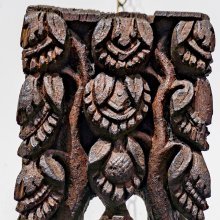Gane, Gaṇe: 2 definitions
Introduction:
Gane means something in biology. If you want to know the exact meaning, history, etymology or English translation of this term then check out the descriptions on this page. Add your comment or reference to a book if you want to contribute to this summary article.
Images (photo gallery)
Biology (plants and animals)
Source: Wisdom Library: Local Names of Plants and DrugsGane [गाने] in the Nepali language is the name of a plant identified with Houttuynia cordata Thunb. from the Saururaceae (Lizard-tail) family having the following synonyms: Houttuynia foetida, Polypara cordata. For the possible medicinal usage of gane, you can check this page for potential sources and references, although be aware that any some or none of the side-effects may not be mentioned here, wether they be harmful or beneficial to health.
Gane [गाने] in the Nepali language, ibid. previous identification.

This sections includes definitions from the five kingdoms of living things: Animals, Plants, Fungi, Protists and Monera. It will include both the official binomial nomenclature (scientific names usually in Latin) as well as regional spellings and variants.
Languages of India and abroad
Kannada-English dictionary
Source: Alar: Kannada-English corpusGaṇe (ಗಣೆ):—
1) [noun] a long bamboo staff.
2) [noun] a stick with zigzag surfaced head at one end, used to stir, beat or shake curd in a churn to make butter; a churn-stick.
3) [noun] a slender shaft with a pointed tip and other end being feathered used to be shot from a bow; an arrow.
4) [noun] an old unit for measuring the area of a land.
5) [noun] a stick of standard length used for this purpose.
6) [noun] the heavy wood or stone which by revolving in a mortar grinds oil-seeds to extract oil, in a bullock-driven oil mill.
7) [noun] a long pole with a broad blade at one end used for propelling or steering a boat; an oar.
8) [noun] the slender, jointed stem of plants as sugarcane, jowar, etc.
9) [noun] the long beam of the plough.
10) [noun] any of the farm implements, as plough, etc.; an agricultural implement.
11) [noun] ಗಣೆ ಮರ [gane mara] gaṇe mara (fig., sometimes sarc.) a tall, lean person; ಡೊಂಬರ ಸಾವು ಗಣೆಯ ಮೇಲೆ, ಬಿಲ್ಲವರ ಸಾವು ಮರದ ಮೇಲೆ [dombara savu ganeya mele, billavara savu marada mele] ḍombara sāvu gaṇeya mēle, billavara sālu marada mēle (prov.) to him he who professes a dangerous profession for his living, the profession may itself prove to be fatal.
--- OR ---
Gane (ಗನೆ):—[verb] to utter a loud, deep, rumbling sound; to roar.
--- OR ---
Gāṇe (ಗಾಣೆ):—[noun] a female singer.
--- OR ---
Gāne (ಗಾನೆ):—[noun] a female singer.
Kannada is a Dravidian language (as opposed to the Indo-European language family) mainly spoken in the southwestern region of India.
See also (Relevant definitions)
Starts with (+115): Gane gurjoo, Gane-dhwang-phul, Gane-gurjo, Ganeeth, Ganegara, Ganegeree, Ganegeri, Ganeli-jhar, Ganem, Ganembajavanem, Ganemoe, Ganendra, Ganendraraja, Ganepashancanga, Ganer, Ganeri, Ganerjei, Ganeru, Ganeruka, Ganesara.
Ends with (+114): Addagane, Aigane, Alagugane, Alargane, Alarugane, Amaradamagane, Amgane, Amgatamgane, Anyamgane, Arogane, Aygane, Bagabagane, Bagane, Baggane, Begane, Belunage, Bhagabhagane, Bhaggane, Bhirimgane, Bhoggane.
Full-text: Ganeya, Gane gurjoo, Ganesha, Parvatinandana, Parvvatinandana, Gane-dhwang-phul, Taragana, Gatri, Gane-gurjo, Dhavaliman, Vinayaka, Cira, Kula.
Relevant text
Search found 19 books and stories containing Gane, Gaṇe, Gāṇe, Gāne; (plurals include: Ganes, Gaṇes, Gāṇes, Gānes). You can also click to the full overview containing English textual excerpts. Below are direct links for the most relevant articles:
Jainism in Odisha (Orissa) (by Ashis Ranjan Sahoo)
Garga Samhita (English) (by Danavir Goswami)
Verse 2.2.25 < [Chapter 2 - Description of Girirāja Govardhana’s Birth]
Bhajana-Rahasya (by Srila Bhaktivinoda Thakura Mahasaya)
Text 6 < [Chapter 7 - Saptama-yāma-sādhana (Pradoṣa-kālīya-bhajana–vipralambha-prema)]
Text 3 < [Chapter 6 - Ṣaṣṭha-yāma-sādhana (Sāyaṃ-kālīya-bhajana–bhāva)]
Text 26 < [Chapter 1 - Prathama-yāma-sādhana (Niśānta-bhajana–śraddhā)]
Chaitanya Bhagavata (by Bhumipati Dāsa)
Verse 3.10.53 < [Chapter 10 - The Glories of Śrī Puṇḍarīka Vidyānidhi]
Verse 1.11.22 < [Chapter 11 - Meeting with Śrī Īśvara Purī]
Verse 1.2.216 < [Chapter 2 - The Lord’s Appearance]
Bhakti-rasamrta-sindhu (by Śrīla Rūpa Gosvāmī)
Verse 1.3.38 < [Part 3 - Devotional Service in Ecstasy (bhāva-bhakti)]
Verse 1.3.26 < [Part 3 - Devotional Service in Ecstasy (bhāva-bhakti)]
Verse 3.3.77 < [Part 3 - Fraternal Devotion (sakhya-rasa)]
Amarakoshodghatana of Kshirasvamin (study) (by A. Yamuna Devi)
Dhruvā songs < [Chapter 4 - Cultural Aspects]
